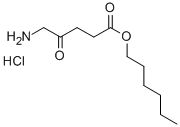140898-91-5

Product Name:
5-Aminolevulinic acid hexyl ester hydrochloride
Formula:
C11H22ClNO3
Inquiry
SAFETY INFORMATION
| Signal word | Danger |
|---|---|
| Pictogram(s) |
 Skull and Crossbones Acute Toxicity GHS06 |
| GHS Hazard Statements |
H315:Skin corrosion/irritation H319:Serious eye damage/eye irritation |
| Precautionary Statement Codes |
P261:Avoid breathing dust/fume/gas/mist/vapours/spray. P264:Wash hands thoroughly after handling. P264:Wash skin thouroughly after handling. P270:Do not eat, drink or smoke when using this product. P271:Use only outdoors or in a well-ventilated area. P280:Wear protective gloves/protective clothing/eye protection/face protection. P305+P351+P338:IF IN EYES: Rinse cautiously with water for several minutes. Remove contact lenses, if present and easy to do. Continuerinsing. P332+P313:IF SKIN irritation occurs: Get medical advice/attention. P337+P313:IF eye irritation persists: Get medical advice/attention. P405:Store locked up. P403+P233:Store in a well-ventilated place. Keep container tightly closed. P501:Dispose of contents/container to..… |
COMPUTED DESCRIPTORS
| Molecular Weight | 251.75 g/mol |
|---|---|
| Hydrogen Bond Donor Count | 2 |
| Hydrogen Bond Acceptor Count | 4 |
| Rotatable Bond Count | 10 |
| Exact Mass | 251.1288213 g/mol |
| Monoisotopic Mass | 251.1288213 g/mol |
| Topological Polar Surface Area | 69.4 Ų |
| Heavy Atom Count | 16 |
| Formal Charge | 0 |
| Complexity | 192 |
| Isotope Atom Count | 0 |
| Defined Atom Stereocenter Count | 0 |
| Undefined Atom Stereocenter Count | 0 |
| Defined Bond Stereocenter Count | 0 |
| Undefined Bond Stereocenter Count | 0 |
| Covalently-Bonded Unit Count | 2 |
| Compound Is Canonicalized | Yes |
PRODUCT INTRODUCTION
description
Hexaminolevulinate Hydrochloride is the hydrochloride salt form of hexaminolevulinate, a hexyl ester of the heme precursor 5-aminolevulinic acid (ALA) with potential photosensitizing activity. Hexaminolevulinate serves as a precursor of photoactive porphyrins (PAPs), particularly protoporphyrin IX (PpIX), which selectively accumulate in rapidly proliferating cells, such as those seen in tumor tissue. When exposed to blue light, PAPs are activated and emit red light thereby allowing tumor imaging.